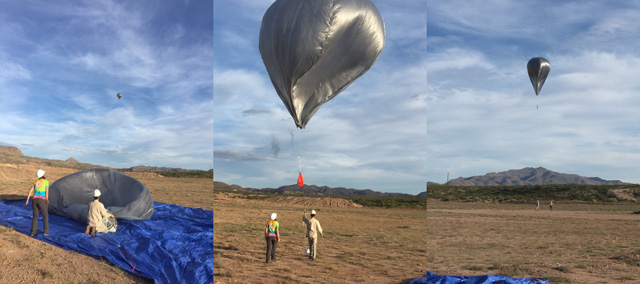19 April 2023–On 24 September, about a cup’s worth of the rocky surface of asteroid Bennu will be returned to Earth in a sample return capsule, ending the 12-year mission of NASA’s OSIRIS-REx spacecraft as it lands in the Utah desert.
Researchers led by Sandia National Laboratories will be “listening” in as it does, taking advantage of the re-entry with a unique seismoacoustic observational campaign, scientists reported at the Seismological Society of America (SSA)’s 2023 Annual Meeting.
The sample capsule is like an “artificial meteor” arriving from interplanetary space at high velocity, said Sandia scientist Elizabeth Silber.
But unlike natural meteors, the sample capsule has a known trajectory and timing, and “we will know the size, the velocity, the entry angle—this can help us study a meteoroid entry from high altitude all the way to the ground with multiple instruments,” Silber said.
Researchers study meteoroids (they are called meteors once they begin to burn up in Earth’s atmosphere) for a variety of reasons: to learn more about interplanetary space, to track potential impact threats, and to understand meteor physics.
Sufficiently fast and large (typically more than 10 centimeters in diameter) meteoroids “can create a shockwave when they enter denser regions of the atmosphere,” Silber explained.
Meteors streak through the atmosphere at a staggering speed of between 11.2 and 72 kilometers per second (roughly between 25,000 and 161,000 miles per hour). The OSIRIS-REx capsule “will be entering at 12.2 kilometers per second, that’s about 27,000 miles per hour. So these are extremely fast,” Silber said.

The resulting shockwaves decay to low-frequency sound (below 20 hertz), also known as infrasound, “which propagates through the atmosphere and can be recorded by very sensitive microphones situated on the ground or attached to high-altitude balloons,” she added.
The Sandia team plans to use a variety of infrasound and seismic instruments all along the sample return capsule’s ground track from Nevada to Utah as it falls through the atmosphere to its eventual landing spot.
The seismoacoustic data can help scientists improve and validate their models that describe a meteoroid’s flight through the Earth’s atmosphere, refine the relationship between a meteoroid’s size and velocity and its infrasound signature, and provide more information about the dynamics of the atmosphere.
Researchers have studied other sample return capsules using infrasound and seismic instruments, including capsules from the NASA Genesis spacecraft, which delivered solar wind particles to a Utah landing zone in 2004, the NASA Stardust spacecraft that returned comet samples in 2006, and Hayabusa 1 and 2, two spacecraft operated by the Japanese space agency JAXA that returned asteroid samples in 2010 and 2020, respectively.
The OSIRIS-REx capsule re-entry will be monitored by many more instruments than these previous missions. The Sandia group even plans to launch several stratospheric balloons containing infrasound sensors, said Sandia scientist Sarah Albert.
Last year, Albert and colleagues used these types of balloons to verify the presence of an atmospheric acoustic duct for the first time.
“This experiment will be even better than that, because it will be better instrumented,” said Albert. “We’re likely to get some insightful results about infrasound propagation through the stratosphere and possibly gain a better understanding of sample return capsule dynamics when they’re entering back into Earth’s atmosphere.”
Silber said the team is working hard to make sure the full observational plan is in place by September.
Unlike a real meteor, they know when and where the capsule is coming, “but this is a one-time shot, and we have no room to gamble,” she said. “So everything has to be planned well ahead.”
